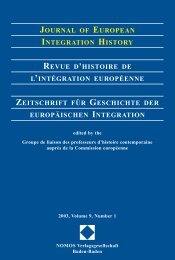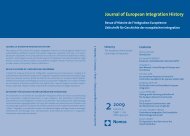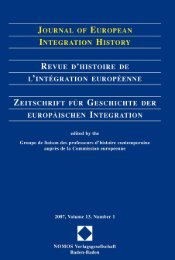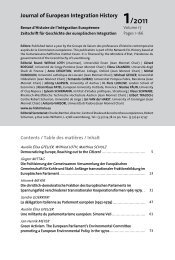journal of european integration history revue d'histoire de l ...
journal of european integration history revue d'histoire de l ...
journal of european integration history revue d'histoire de l ...
You also want an ePaper? Increase the reach of your titles
YUMPU automatically turns print PDFs into web optimized ePapers that Google loves.
138Book reviews – Comptes rendus – BuchbesprechungenCinzia Rognoni Vercelli, in her essay “Luciano Bolis, eroe <strong>de</strong>lla resistenza e patriotaeuropeo”, gives us an engaging picture <strong>of</strong> one <strong>of</strong> the leading figures <strong>of</strong> the EuropeanFe<strong>de</strong>ralist movement; Milanese by birth but Genoese by adoption, Bolis, who shared manyi<strong>de</strong>as with Altiero Spinelli, was a very charismatic figure, thanks to his brilliant exploits inthe Genoese resistance movement.Guido Levi’s essay “Il movimento fe<strong>de</strong>ralista europeo a Genova e in Liguria(1945-1954)” provi<strong>de</strong>s us with a fascinating account <strong>of</strong> the evolution which the Fe<strong>de</strong>ralistMovement un<strong>de</strong>rwent in the first ten years <strong>of</strong> its activity, the choice it had to make regardingadhesion or non-adhesion to the Marshall Plan - which would involve the launching <strong>of</strong> thereconstruction <strong>of</strong> Europe - which faced the countries <strong>of</strong> Europe, and consequently thedivisions which would be created insi<strong>de</strong> the movement itself. He dwells in particular on thedivisions in Genoa, and more generally on those in Liguria, where the majority <strong>of</strong> theFe<strong>de</strong>ralists had been members <strong>of</strong> the resistance movement.Danila Preda is the author <strong>of</strong> a long and well-informed article entitled “L’Europa di PaoloEmilio Taviani. Dalla resistenza ai trattati di Roma (1944-1957)”. In this work she presents uswith the story <strong>of</strong> another famous Genoese who, in the 1950s, was a protagonist in the activities <strong>of</strong>governmental Europeanism when this was experiencing a period <strong>of</strong> particular fervour un<strong>de</strong>r theguidance <strong>of</strong> the presi<strong>de</strong>nt <strong>of</strong> the council, Alci<strong>de</strong> De Gasperi. Taviani, first as presi<strong>de</strong>nt <strong>of</strong> theItalian <strong>de</strong>legation at the conference <strong>of</strong> the European Coal and Steel Community (ECSC), then atthe conference <strong>of</strong> European Defence Community (EDC), and later as un<strong>de</strong>r-secretary for Foreignaffairs for De Gasperi’s seventh government, carried out an important part in setting up the twocommunity organisations. It was Taviani who organised the Italo-French summit meeting atSanta Margherita Ligure <strong>of</strong> February 1951 which led to an agreement between those twocountries regarding the EDC and its political implications. And it was at Genoa, in June 1952,where alongsi<strong>de</strong> Taviani, Paul-Henri Spaak, the presi<strong>de</strong>nt <strong>of</strong> the European movement, appearedand that on the eve <strong>of</strong> his journey to Rome, where he would seal his agreement with De Gasperi,anticipating their discussions regarding the issues raised by article 38 <strong>of</strong> the EDC.The local Genoan press, even though little has been written about it - as Daniela Predanotes in her aforementioned introduction - did contribute in some way to divulgeinformation about Europeanism. Giovanni B. Varnier’s essay gives us a richly <strong>de</strong>tailedpicture <strong>of</strong> the Europeanist efforts <strong>of</strong> the editor-in-chief <strong>of</strong> the “Corriere <strong>de</strong>l Pomeriggio”,Lazzaro Maria <strong>de</strong> Bernardis, in the years 1948-1961.Giorgio Grimaldi, in his interesting essay entitled “Europeismo ed economia: Manzitti,Minoletti e la camera di Commercio di Genova (1945-1958)” notes how the GenoeseChamber <strong>of</strong> commerce, through its presi<strong>de</strong>nt and various enlightened collaborators,assumed an important role in the 1950s as an instigator in favour <strong>of</strong> European unity aroundwhich the local Europeanism revolved.In her essay “Giancarlo Piombino, sindaco di Genova e presi<strong>de</strong>nte <strong>de</strong>ll’AICCE”, LaraPiccardo <strong>de</strong>scribes the man who was mayor <strong>of</strong> Genoa from 1971 to 1975 and presi<strong>de</strong>nt <strong>of</strong>the Italian Association for the Council <strong>of</strong> the Municipalities <strong>of</strong> Europe (AICCE) from 1969to 1981 and since 1972 also presi<strong>de</strong>nt <strong>of</strong> the European Conference <strong>of</strong> Local Powers, one <strong>of</strong>the first forms <strong>of</strong> institutionalised representation and participation <strong>of</strong> the local and territorialbodies in the process <strong>of</strong> continental <strong>integration</strong> created by the Council <strong>of</strong> Europe.The last section <strong>of</strong> the book gathers together the testimonies <strong>of</strong> some sixteen people whowere either Genoese or who were connected in some way to the economic, political orcultural world <strong>of</strong> Genoa or Liguria at the end <strong>of</strong> the 1940s or in the early 1950s, who carriedout roles <strong>of</strong> varying importance in the European Fe<strong>de</strong>ralist movement and who, in their ownway, contributed to the <strong>history</strong> <strong>of</strong> the European Union.Anna Be<strong>de</strong>schiUniversità di Padova
















